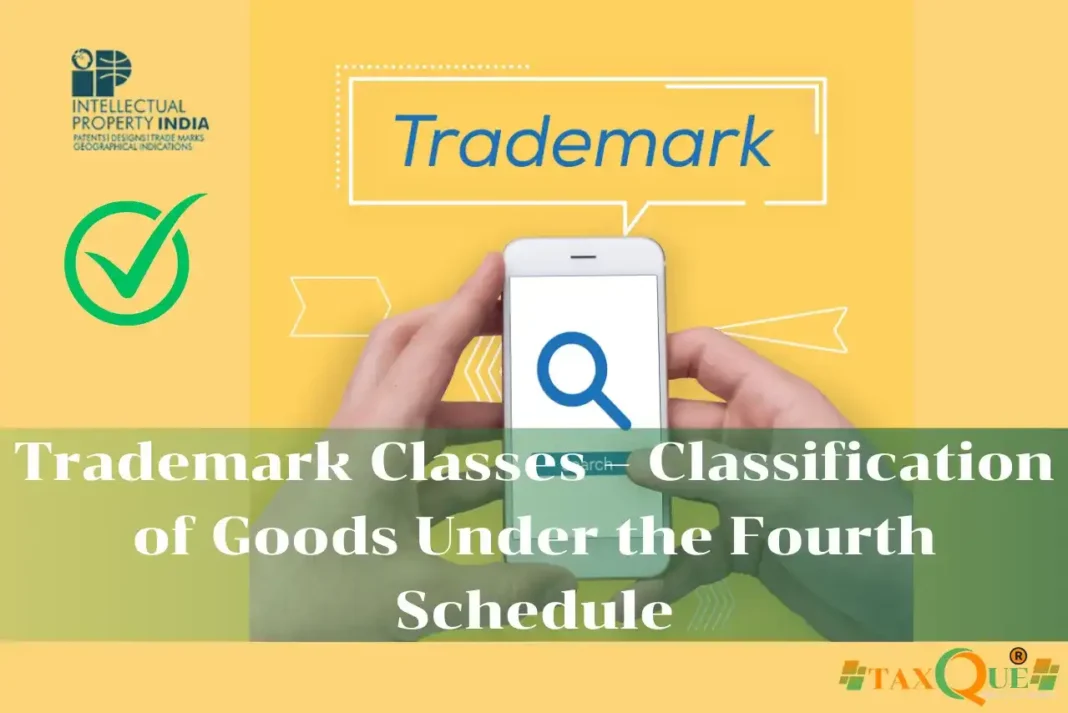Understanding Trademark Classes for Goods in India: What You Need to Know
Introduction
When registering a trademark in India, selecting the correct class is crucial for protecting your brand. The Indian Trademark Rules define 34 classes of goods under the Fourth Schedule. This classification helps determine the scope of protection and avoids potential legal conflicts. Here’s a comprehensive guide to each class under the Fourth Schedule for goods.
Category: Trademark Classification of Goods (Fourth Schedule)
Below are the 34 classes of goods categorized under the Fourth Schedule of the Indian Trademark Rules:
Class 1 – Industrial & Chemical Products
Includes chemicals used in industry, science, agriculture, and related fields, including unprocessed plastics, adhesives for industrial use, etc.
Class 2 – Paints & Coatings
Comprises paints, varnishes, lacquers, preservatives, and metal powders used by artists and decorators.
Class 3 – Cleaning & Cosmetic Products
Includes soaps, perfumery, essential oils, cleaning and polishing substances, and cosmetic preparations.
Class 4 – Oils, Greases & Fuels
Covers industrial oils, lubricants, fuels, and candles.
Class 5 – Pharmaceuticals & Sanitary Products
Includes medicines, disinfectants, medical foods, plasters, dental wax, and pest control substances.
Class 6 – Metals & Hardware
Encompasses common metals, building materials, pipes, metal safes, and ore.
Class 7 – Machinery & Mechanical Equipment
Includes machines, engines (excluding land vehicles), and agricultural implements.
Class 8 – Hand Tools & Implements
Covers hand-operated tools, cutlery, razors, and side arms.
Class 9 – Scientific & Technological Apparatus
Includes electronic devices, data processing tools, fire extinguishers, and measuring instruments.
Class 10 – Medical Instruments
Covers surgical, dental, and veterinary tools, orthopaedic articles, and artificial limbs.
Class 11 – Appliances & Sanitary Equipment
Includes lighting, heating, cooking, refrigeration, and water supply appliances.
Class 12 – Vehicles & Transport Equipment
Encompasses all vehicles and apparatus for locomotion by land, air, or sea.
Class 13 – Firearms & Explosives
Includes firearms, ammunition, and fireworks.
Class 14 – Jewellery & Timepieces
Covers precious metals, jewellery, watches, and related accessories.
Class 15 – Musical Instruments
Includes all musical instruments and their components.
Class 16 – Paper Goods & Stationery
Encompasses paper products, printed matter, office supplies, and packaging material.
Class 17 – Rubber & Plastic Materials
Covers rubber, plastic, mica, and insulation or packing materials not in other classes.
Class 18 – Leather Goods & Travel Accessories
Includes bags, leather products, umbrellas, and saddlery.
Class 19 – Construction Materials (Non-metallic)
Includes non-metal building materials, asphalt, and monuments.
Class 20 – Furniture & Non-Metallic Decor Items
Covers furniture, mirrors, picture frames, and plastic or wood products.
Class 21 – Household Items & Utensils
Includes utensils, containers, sponges, brushes, and non-metal cleaning articles.
Class 22 – Ropes, Nets & Textile Raw Materials
Covers ropes, tents, awnings, and raw textile fibers.
Class 23 – Threads & Yarns
Encompasses yarns and threads used in textile manufacturing.
Class 24 – Textiles & Covers
Includes fabrics, linens, bed and table covers.
Class 25 – Apparel & Accessories
Covers clothing, footwear, and headgear.
Class 26 – Haberdashery & Decorations
Includes lace, embroidery, ribbons, buttons, and artificial flowers.
Class 27 – Carpets & Floor Coverings
Encompasses rugs, mats, linoleum, and wall hangings.
Class 28 – Games & Sports Equipment
Includes toys, sports goods, and festive decorations.
Class 29 – Food Items (Animal-Based)
Covers meat, fish, eggs, milk, oils, and preserved food products.
Class 30 – Staple Foods & Condiments
Includes coffee, tea, rice, bread, spices, and baking products.
Class 31 – Agricultural Products & Fresh Produce
Encompasses seeds, plants, live animals, and food for animals.
Class 32 – Non-Alcoholic Beverages
Covers soft drinks, juices, syrups, and mineral water.
Class 33 – Alcoholic Beverages
Includes all alcoholic drinks except beer.
Class 34 – Tobacco & Related Products
Covers tobacco, smokers’ articles, and matches.
Conclusion
Understanding the correct trademark class is crucial when applying for a trademark in India. Misclassification can lead to legal disputes and lack of protection. Use this guide to determine the appropriate class for your products and ensure effective brand safeguarding.
FAQs
Q1. Why is trademark classification important?
Trademark classification determines the scope of protection and avoids overlaps with existing trademarks in different sectors.
Q2. How many trademark classes are there for goods in India?
There are 34 classes under the Fourth Schedule for goods.
Q3. Can one trademark be registered under multiple classes?
Yes, a trademark can be registered under multiple classes if it spans multiple categories.
Q4. What is the difference between goods and services in trademark classes?
Goods are tangible products (Classes 1–34), while services are covered under a separate schedule (Classes 35–45).
Q5. Where can I find the official classification list?
The classification is detailed in the Fourth Schedule of the Trade Marks Rules, 2017, published by the Government of India.
Official Source – Controller General of Patents, Designs & Trade Marks





